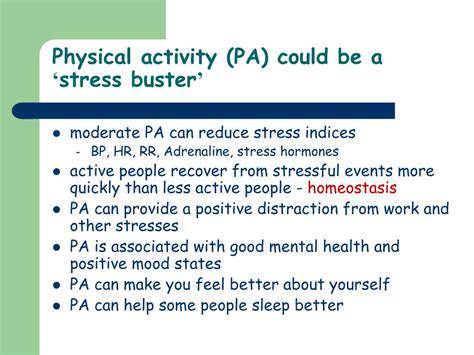Effective Techniques to Lower Anxiety Levels Naturally
Physical Activity as a Stress Buster

Engaging in Physical Activity for Stress Reduction
Movement serves as nature's antidepressant. Exercise stimulates endorphin release while metabolizing excess stress hormones, creating a natural relaxation response. Whether through structured workouts or lifestyle activities like gardening, physical exertion provides a healthy outlet for nervous energy.
The most effective exercise regimen is one you'll maintain. Brief but frequent movement breaks often prove more sustainable than occasional intense sessions. A 10-minute walk after meals or some gentle stretching during work breaks can cumulatively make a significant difference.
Different Forms of Physical Activity for Stress Management
Variety prevents boredom while addressing different aspects of stress. Cardiovascular exercise improves circulation and oxygenation. Strength training builds confidence and resilience. Mind-body practices like qigong integrate movement with breath awareness for deep relaxation. Alternating between these modalities creates comprehensive stress protection.
Physical Activity's Impact on the Mind-Body Connection
Regular movement recalibrates the stress response system. By lowering baseline cortisol levels, exercise makes us less reactive to daily stressors. Improved sleep quality from daytime exertion further enhances emotional regulation, creating a virtuous cycle of increasing resilience.
The Importance of Choosing Activities You Enjoy
Long-term adherence depends on finding activities that spark joy rather than feel like obligations. Some thrive on social sports while others prefer solitary nature walks. Experimentation helps discover what movement forms feel most rejuvenating rather than draining. When exercise feels like play rather than work, it becomes self-reinforcing.
The Role of Exercise in Emotional Regulation
Physical activity provides a constructive channel for processing difficult emotions. The rhythmic nature of many exercises creates a meditative state that helps diffuse emotional intensity. Many find that solutions to problems emerge spontaneously during or after physical exertion as the mind clears.
Integrating Physical Activity into Your Daily Routine
Successful movement integration relies on strategic habit stacking. Pairing exercise with existing routines - like doing squats while brushing teeth or taking walking meetings - makes it effortless. Keeping workout clothes visible serves as a visual prompt. Small, consistent actions compound into significant results over time.
Cultivating a Supportive Lifestyle
Creating a Safe and Nurturing Environment
Our surroundings profoundly influence our mental state. Decluttering physical spaces reduces cognitive load while incorporating calming elements like plants or soft lighting creates sanctuaries for restoration. Equally important is curating social environments with people who uplift rather than drain us.
Implementing Self-Care Practices Regularly
True self-care goes beyond occasional treats to establish foundational habits. Consistent sleep schedules, nutritious meals, and movement form the bedrock. When these basics are in place, we have greater capacity to handle life's inevitable stresses. Layering in enjoyable activities - whether creative pursuits or nature immersion - provides necessary counterbalance to daily demands.
Mindfulness practices train us to respond rather than react to stressors. Simple breath awareness exercises throughout the day create space between stimulus and response. This cultivated awareness helps prevent minor irritations from escalating into major upsets.